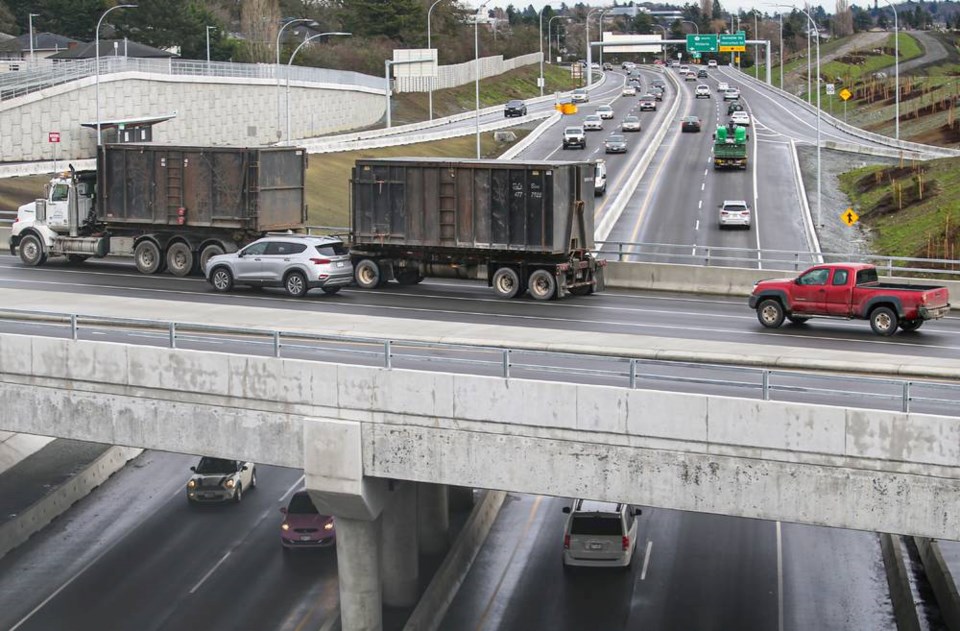Maybe our internal panic buttons can only handle one beyond-our-control market manipulation at a time, and vaccines trump gasoline.
Or maybe the price at the pump doesn’t seem like that big a deal when your car is on fire. The pandemic will do that to a person’s perspective: Irritants that used to set you off, cussing and fussing like Don Cherry wiping dog crap off his shoe, no longer seem that important.
Case in point: Gas prices jumped close to eight cents a litre the other day, hitting $1.359 at most stations, and Victorians merely shrugged. Normally, a spike like that would fill the letters-to-the-editor with A) smugness from those who don’t drive gas-powered vehicles, and B) angry demands that government rein in Big Oil.
In fact, it was a big jump in the spring of 2019 — some Vancouverites were paying $1.70 — that inspired/pressured Premier John Horgan to order an inquiry into gas costs (although its terms of reference conveniently ignored the role of taxation).
The B.C. Utilities Commission’s subsequent report found that when comparing Greater Vancouver to the Pacific Northwest, there was “a significant unexplained difference of approximately 13 cents a litre” that wholesalers couldn’t explain. The investigating panel also said a handful of wholesalers constituted an “oligopoly” whose control over distribution networks left retailers without alternative sources.
So, B.C. brought in the Fuel Price Transparency Act, requiring fuel suppliers to make certain data public, the idea being that pulling off the veil of secrecy would nudge the companies toward fairer pricing. Critics had their doubts, arguing that much of the information was already public (apparently the veil wasn’t that thick) and that disclosure of the numbers hadn’t resulted in Big Oil turning pink at the ears and slashing prices.
Never mind, the provincial government forged ahead, announcing that the utilities commission would have the job of collecting and publishing the data, the idea being to promote more competition at the pump.
That was March 9. Two days later, the World Health Organization declared a pandemic, Tom Hanks tested positive and the NBA pulled the plug on its season. COVID-19 was here.
Victoria’s streets emptied almost overnight. The capital looked like I Am Legend. Even at midday, the whole city resembled Oak Bay after dark, not a car in sight.
Gas prices fell below $1, not that it mattered, since no one was going anywhere, anyway. Turns out that when it comes to suppressing prices, greed-shaming isn’t nearly as effective as the plague.
But now the roads are full(ish) again. Today’s Victoria gas prices are just 3.3 cents lower than they were at this time last year. And, according to one petroleum analyst, they might hit $1.50 this spring.
“Unfortunately, I think we’re going to progressively go higher,” said the GasBuddy website’s Patrick De Haan, on the phone from Chicago on Tuesday.
It’s supply and demand, he said. With OPEC carefully controlling production, oil prices have been climbing since November. At the same time, Americans are driving again; prior to last week, U.S. gas prices rose four weeks in a row as vaccines began to arrive and optimism grew.
But why would Victoria’s price jump eight cents when the rest of the province stayed flat? Because the capital tends not to see the volatility of other B.C. cities, De Haan said. Gas stations here tend to adjust prices in concert, then leave them unchanged for weeks.
“The wholesale price is largely ignored in Victoria until everyone goes up at the same time,” he said. Prior to the most recent increase, Victoria gas prices had only moved once since October, even as oil prices steadily rose.
OK, we’re always given some explanation for fluctuations: Eastern cold snaps that drive the demand for heating oil; refinery fires; California eco-requirements; holiday travel in the U.S. West Coast market that drives our costs. (Our distribution systems are linked. Note that 63 per cent of the product moving through the existing maxed-out Trans Mountain pipeline last year was Alberta crude diverted to Puget Sound refineries via a spur line from the Fraser Valley.)
Whatever. The bottom line is the bottom line, looming over you in big numbers every time you pass the gas station. Maybe if grocers did the same with lettuce and cauliflower, posting prices on roadside marquees, we’d howl for a public inquiry to bring Big Vegetable into line, too.
Or maybe we’d pay more attention to climate change if the numbers were in our faces every day.
Or maybe we’re too preoccupied with vaccines and case counts to worry about anything else.
jknox@timescolonist.com



